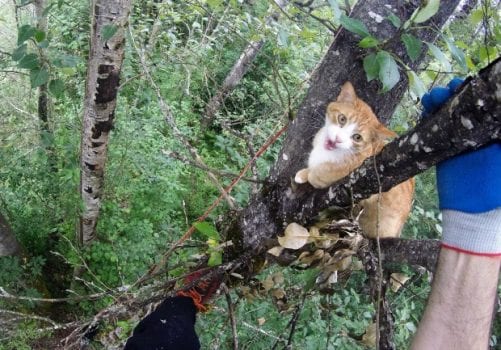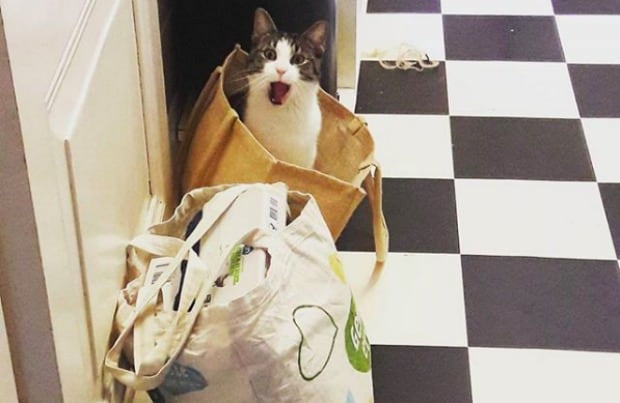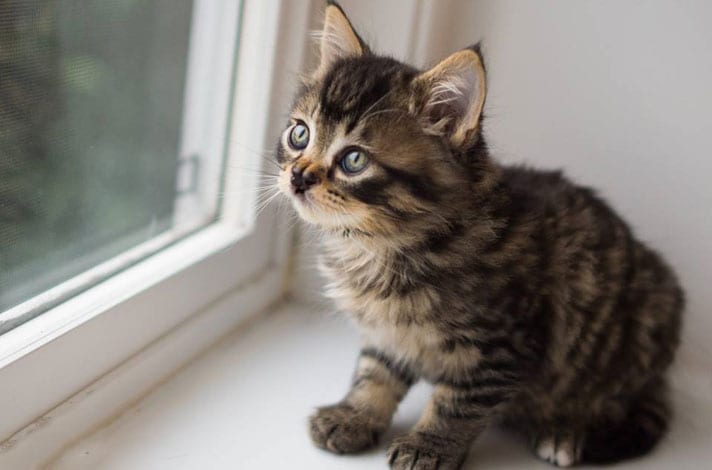It all started with Hamburger Belly. The female tabby was stuck nearly six stories in the air, swaying on the limb of a fir tree in her owner’s yard.
As Shaun Sears inched up in his harness to rescue the cat, he called down to Hamburger Belly’s owner that she didn’t seem happy to see him.
“Oh yeah, she hates men,” the owner called back.
Unlike Hamburger Belly, most cats who have been stuck in a tree for days (and sometimes weeks!) are delighted to see Sears and his partner, Tom Otto, owners of Canopy Cat Rescue. Since their 2009 launch, the two have rescued more than 2,000 cats from trees throughout Washington State’s backyards, forests and neighborhoods.

“In Washington State, and throughout the Pacific Northwest, we have a lot of tall trees. It’s difficult for people in other parts of the country to understand why this is such a big problem. They’ve never seen a 100-plus foot Douglas-fir,” says Sears. “A cat’s not going to be able to smell the can of tuna you leave at the base of a tree that high.”
Otto and Sears are professional arborists, experts who know the ins and outs of tree care and health. They can tell a Western Hemlock from a Western Red Cedar; a Ponderosa Pine from a Pacific Yew. They’re also both professional tree climbers.
In 2007, the two friends started their own business, Canopy Conservation, to take a break from tree care and pruning to do what they call “the fun stuff”—working with local governments and wildlife groups to build osprey nests and install cameras in eagle, owl, and heron nests.
As business picked up, they started receiving calls from desperate pet owners whose cats had climbed up a tree—maybe they were outrunning a dog or coyote, or chasing a squirrel up a sequoia—and couldn’t get down.
At first Otto and Sears charged between $75 and $150 for each rescue, small potatoes compared to other arborists’ quotes of $500 to $700. But if they heard the slightest hint of hesitation on the caller’s end after the cost came up, they would make the rescue on the house.
Their pro-bono customers were beyond grateful. Some had been so desperate they were willing to pawn wedding rings and family jewelry for their cat’s safe return. That’s when the idea to start a rescue company that ran solely on donations came into the picture.
“We believe all cats deserve to be rescued, regardless of someone’s ability to pay,” Sears says.

The guys’ special skillsets and unique approach to saving felines caught attention from the media, and their popularity snowballed. They got a few articles in local papers. The news channels came out. They even had a stint on Animal Planet.
“That opened our eyes to the possibility that this is a much-needed community service,” says Otto.
Now they’re handling multiple calls a day, climbing as high as 150 to 170 feet to rescue cats in return for gas money and maybe a little extra for their time. So far, the donations are enough to keep them in business.
Canopy Cat Rescue recently received non-profit status from Washington State, which will help them collect more donations and rescue even more cats.
On average, the cats Tom and Shaun rescue have been treebound for a few days. But last year they rescued a cat named Boots who had been stuck for two weeks in Lebanon, Oregon. The location was way beyond Canopy Cat Rescue’s coverage zone. But the owner was desperate. It was a long weekend and she couldn’t find anyone to help her.
“I was like, ‘I can be there in five hours,’” Sears says.
When Boots was placed in her arms, the owner burst into tears. Like many of the pet parents they work with, she had lost hope.
“They’re beside themselves,” says Sears. “We get folks when they’re at that point of thinking their cat is dead. In a lot of cases they’re almost in shock after the rescue. Then other times they’re so overwhelmed with joy and emotion they can’t hold it in.”
“We believe all cats deserve to be rescued, regardless of someone’s ability to pay.”
When Otto or Sears arrive on scene, they interview the cat owner to get a sense of the animal’s personality (that experience with Hamburger Belly taught them a thing or two). The rescuers try to mimic how the cat’s owner speaks to them. They take classes on how to approach and handle freaked out felines.
It’s dangerous work. Owners have to sign a release and are fully briefed on the risks involved. In their seven years of business Canopy Cat Rescue has had just one cat fatality and a few minor injuries.
“It’s very unpredictable. We’ve had cats jump 130 feet and be completely okay,” Sears says.
In addition to the normal tree climbing gear of harnesses, ropes, and helmets, Shaun and Tom also carry bite-proof gloves, cat-sized rope bags and a calming pheromone spray. If a cat is stuck in a tree that’s too skinny or sick to support the weight of a human, they’ll break out a net and a telescoping pole that can extend up to 25 feet.
If the owner isn’t present, Sears and Otto use a microchip scanner to identify the cat. The scanner was a gift from a fundraising campaign started by one of their Facebook fans. It nabbed them more than a thousand bucks in two hours.
“It feels so good to say we do this just for the donation, for whatever the owner can afford,” says Otto. “It gives our tree climbing careers more focus, and in a selfish way, it makes me look forward to every day I get to do a cat rescue.”
Images: Courtesy Canopy Cat Rescue via Facebook

Helen Anne Travis is a freelance writer based in Tampa, FL. She also writes for CNN, The Guardian and The Globe and Mail.
Share:









